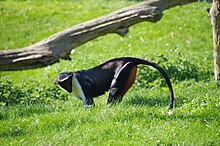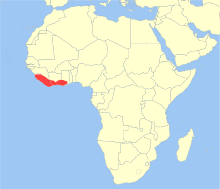Diana monkey
| Diana monkey[1] | |
|---|---|

| |
| Diana monkey at the Zoo de la Bourbansais | |
| Scientific classification | |
| Domain: | Eukaryota |
| Kingdom: | Animalia |
| Phylum: | Chordata |
| Class: | Mammalia |
| Order: | Primates |
| Suborder: | Haplorhini |
| Infraorder: | Simiiformes |
| Family: | Cercopithecidae |
| Genus: | Cercopithecus |
| Species: | C. diana
|
| Binomial name | |
| Cercopithecus diana | |

| |
| Combined geographic range of Diana monkey (western half) and roloway monkey (eastern half) | |
| Synonyms[5] | |
| |
The Diana monkey (Cercopithecus diana) is an
Taxonomy
Two
Distribution
This species can be found in
Habitat
The Diana monkey is found in the primary forests, and does not thrive in secondary forests. The species is regarded as
Description
The Diana monkey ranges from 40 to 55 cm in length, excluding its tail, which is of a uniform 3–4 cm diameter and 50–75 cm long. Adults weigh between 4–7 kg.
They are generally black or dark grey, but have a white throat, crescent-shaped browband, ruff and beard; the browband gave the species its common name, since it was held to resemble the crescent on the brow of the goddess Diana. The monkeys' underarms are also white, and they have a white stripe down their thighs, while the backs of their thighs, and their lower backs, are a chestnut colour. Apart from the browband, ruff and beard, and some fringes on their limbs, their fur is rough and tough.
Biology and behavior
Individual, healthy Diana monkeys may live for up to 20 years. This species of monkey is active during the day, and feeds at all levels of the canopy, rarely venturing down to the ground for fear of predation. Diana monkeys retreat to the upper levels of the trees at night, though they do not make nests, preferring to sleep on branches. They feed mainly on fruit, blossoms and leaves, as well as occasional insects and invertebrates. The monkeys, in turn, are hunted and preyed upon by various animals, including the
The Diana monkey is a noisy presence in the forest. Its marked coloration allows a wide range of visual social signals. Female Diana monkeys produce specific alarm calls, alert calls and greeting/contact calls, depending on the occasion; in moments of predatory threat, they utilise distinct calls based on the specific predator in question, with some research suggesting that the vocabulary of the females’ vocalisations is larger and more variable than that of the males.[7]
Other forest residents, such as the
Diana Monkeys communicate both to local group members and distant competitors with different kind of alarm sounds. Diana Monkeys produce loud noises to make other monkeys aware of leopards or other competitors in their area.
Groups consist of a single male with a number of reproducing females and their infants. In good conditions, adult females reproduce annually. Gestation lasts about 5 months, and the young nurse for a further 6 months. Normally, only a single infant is born. Although the young are born in a fairly well-developed condition, with open eyes and able to grasp their mothers, at least in zoo conditions, Diana monkey mothers appear anxious and possessive, rarely letting young infants leave them. As infants grow, however, they become very playful. Juveniles reach sexual maturity at an age of about 3 years. Daughters remain in their mothers' social groups, while males leave their natal groups shortly before attaining sexual maturity.
Human relevance
Like most primates, Diana monkeys can carry diseases that can be communicated to humans, like yellow fever and tuberculosis.[9] Native tribes in the tropical forest of West Africa poach Diana monkeys, which are sold as luxury meat and seen as a commodity.[10]
Gallery
-
A Diana monkey seen in profile.
-
Diana monkey at theHenry Doorly Zoo.
-
Exemplar inMunich Zoo.
-
Cercopithecus diana in Singapore Zoo. Video clip
References
- OCLC 62265494.
- . Retrieved 19 November 2021.
- ^ "Appendices | CITES". cites.org. Retrieved 2022-01-14.
- ^ Linnaeus, Carl von (1758). Systema naturæ. Regnum animale (10th ed.). Guilielmus Engelmann. pp. 26–27. Retrieved 19 November 2012.
- OCLC 62265494.
- S2CID 46858898.
- S2CID 17709446.
- PMID 15209110.
- ^ Macdonald, D. (1984). Encyclopedia of mammals. New York, USA: Facts on File Publications.
- S2CID 85918760.
External links
 Media related to Cercopithecus diana at Wikimedia Commons
Media related to Cercopithecus diana at Wikimedia Commons




